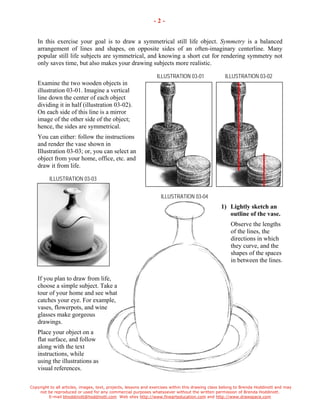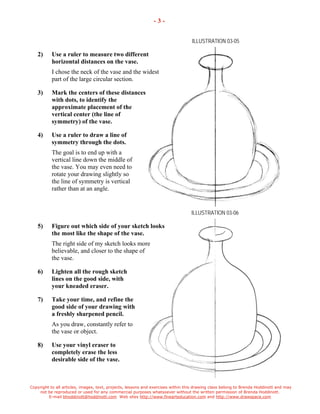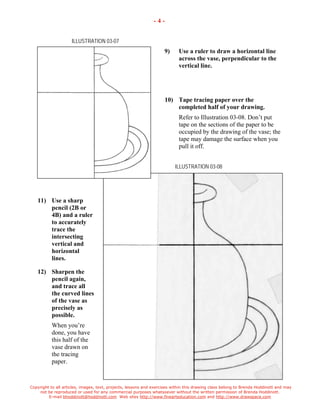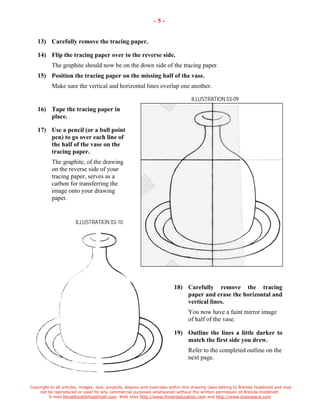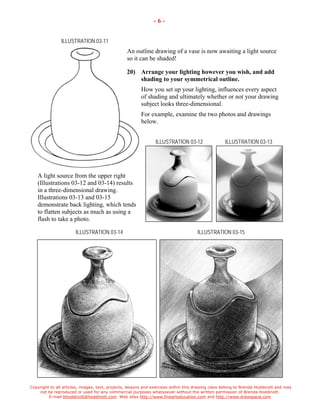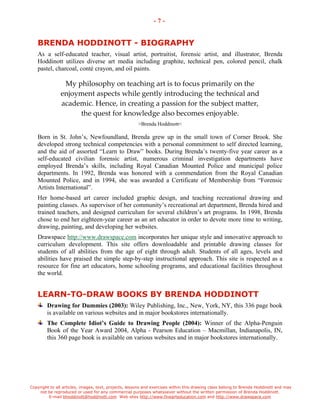Drawspace j03
- 1. SSSEEECCCRRREEETTT Brenda Hoddinott J-03 INTERMEDIATE: SKILLS & SECRETS Many popular still life subjects are symmetrical. Knowing how to employ a short cut for rendering symmetry, not only saves time, but can also make your drawing subjects look more accurate. Back in the day of the dinosaur, a commercial art teacher showed me this method of drawing symmetrical objects. It has proven invaluable for numerous aspects of my lengthy art career including graphic design, forensic art, jewelry design, and the rendering of portraits and still life. In this project, your goal is to draw a symmetrical still life object. You can either follow the instructions to render the vase in this lesson, or you can select an object from your home, office, etc., and draw from life. If you plan to draw from life, choose a simple subject. Take a tour of your home and see what catches your eye; for example, vases, flowerpots, and wine glasses make gorgeous drawings. Suggested drawing supplies include paper, pencils, erasers, a pencil sharpener, a ruler, and a sheet of tracing paper. This project is recommended for artists from age 12 to adult, as well as home schooling, academic and recreational fine art educators. 7 PAGES ¨C 15 ILLUSTRATIONS Published by Hoddinott Fine Art Publishers, Halifax, NS, Canada ¨C Revised 2006
- 2. Copyright to all articles, images, text, projects, lessons and exercises within this drawing class belong to Brenda Hoddinott and may not be reproduced or used for any commercial purposes whatsoever without the written permission of Brenda Hoddinott. E-mail bhoddinott@hoddinott.com Web sites http://www.finearteducation.com and http://www.drawspace.com - 2 - In this exercise your goal is to draw a symmetrical still life object. Symmetry is a balanced arrangement of lines and shapes, on opposite sides of an often-imaginary centerline. Many popular still life subjects are symmetrical, and knowing a short cut for rendering symmetry not only saves time, but also makes your drawing subjects more realistic. ILLUSTRATION 03-01 ILLUSTRATION 03-02 Examine the two wooden objects in illustration 03-01. Imagine a vertical line down the center of each object dividing it in half (illustration 03-02). On each side of this line is a mirror image of the other side of the object; hence, the sides are symmetrical. You can either: follow the instructions and render the vase shown in Illustration 03-03; or, you can select an object from your home, office, etc. and draw it from life. ILLUSTRATION 03-03 ILLUSTRATION 03-04 1) Lightly sketch an outline of the vase. Observe the lengths of the lines, the directions in which they curve, and the shapes of the spaces in between the lines. If you plan to draw from life, choose a simple subject. Take a tour of your home and see what catches your eye. For example, vases, flowerpots, and wine glasses make gorgeous drawings. Place your object on a flat surface, and follow along with the text instructions, while using the illustrations as visual references.
- 3. Copyright to all articles, images, text, projects, lessons and exercises within this drawing class belong to Brenda Hoddinott and may not be reproduced or used for any commercial purposes whatsoever without the written permission of Brenda Hoddinott. E-mail bhoddinott@hoddinott.com Web sites http://www.finearteducation.com and http://www.drawspace.com - 3 - ILLUSTRATION 03-05 2) Use a ruler to measure two different horizontal distances on the vase. I chose the neck of the vase and the widest part of the large circular section. 3) Mark the centers of these distances with dots, to identify the approximate placement of the vertical center (the line of symmetry) of the vase. 4) Use a ruler to draw a line of symmetry through the dots. The goal is to end up with a vertical line down the middle of the vase. You may even need to rotate your drawing slightly so the line of symmetry is vertical rather than at an angle. ILLUSTRATION 03-06 5) Figure out which side of your sketch looks the most like the shape of the vase. The right side of my sketch looks more believable, and closer to the shape of the vase. 6) Lighten all the rough sketch lines on the good side, with your kneaded eraser. 7) Take your time, and refine the good side of your drawing with a freshly sharpened pencil. As you draw, constantly refer to the vase or object. 8) Use your vinyl eraser to completely erase the less desirable side of the vase.
- 4. Copyright to all articles, images, text, projects, lessons and exercises within this drawing class belong to Brenda Hoddinott and may not be reproduced or used for any commercial purposes whatsoever without the written permission of Brenda Hoddinott. E-mail bhoddinott@hoddinott.com Web sites http://www.finearteducation.com and http://www.drawspace.com - 4 - ILLUSTRATION 03-07 9) Use a ruler to draw a horizontal line across the vase, perpendicular to the vertical line. 10) Tape tracing paper over the completed half of your drawing. Refer to Illustration 03-08. DonˇŻt put tape on the sections of the paper to be occupied by the drawing of the vase; the tape may damage the surface when you pull it off. ILLUSTRATION 03-08 11) Use a sharp pencil (2B or 4B) and a ruler to accurately trace the intersecting vertical and horizontal lines. 12) Sharpen the pencil again, and trace all the curved lines of the vase as precisely as possible. When youˇŻre done, you have this half of the vase drawn on the tracing paper.
- 5. Copyright to all articles, images, text, projects, lessons and exercises within this drawing class belong to Brenda Hoddinott and may not be reproduced or used for any commercial purposes whatsoever without the written permission of Brenda Hoddinott. E-mail bhoddinott@hoddinott.com Web sites http://www.finearteducation.com and http://www.drawspace.com - 5 - 13) Carefully remove the tracing paper. 14) Flip the tracing paper over to the reverse side. The graphite should now be on the down side of the tracing paper. 15) Position the tracing paper on the missing half of the vase. Make sure the vertical and horizontal lines overlap one another. ILLUSTRATION 03-09 16) Tape the tracing paper in place. 17) Use a pencil (or a ball point pen) to go over each line of the half of the vase on the tracing paper. The graphite, of the drawing on the reverse side of your tracing paper, serves as a carbon for transferring the image onto your drawing paper. ILLUSTRATION 03-10 18) Carefully remove the tracing paper and erase the horizontal and vertical lines. You now have a faint mirror image of half of the vase. 19) Outline the lines a little darker to match the first side you drew. Refer to the completed outline on the next page.
- 6. Copyright to all articles, images, text, projects, lessons and exercises within this drawing class belong to Brenda Hoddinott and may not be reproduced or used for any commercial purposes whatsoever without the written permission of Brenda Hoddinott. E-mail bhoddinott@hoddinott.com Web sites http://www.finearteducation.com and http://www.drawspace.com - 6 - ILLUSTRATION 03-11 An outline drawing of a vase is now awaiting a light source so it can be shaded! 20) Arrange your lighting however you wish, and add shading to your symmetrical outline. How you set up your lighting, influences every aspect of shading and ultimately whether or not your drawing subject looks three-dimensional. For example, examine the two photos and drawings below. ILLUSTRATION 03-12 ILLUSTRATION 03-13 A light source from the upper right (Illustrations 03-12 and 03-14) results in a three-dimensional drawing. Illustrations 03-13 and 03-15 demonstrate back lighting, which tends to flatten subjects as much as using a flash to take a photo. ILLUSTRATION 03-14 ILLUSTRATION 03-15
- 7. Copyright to all articles, images, text, projects, lessons and exercises within this drawing class belong to Brenda Hoddinott and may not be reproduced or used for any commercial purposes whatsoever without the written permission of Brenda Hoddinott. E-mail bhoddinott@hoddinott.com Web sites http://www.finearteducation.com and http://www.drawspace.com - 7 - BRENDA HODDINOTT - BIOGRAPHY As a self-educated teacher, visual artist, portraitist, forensic artist, and illustrator, Brenda Hoddinott utilizes diverse art media including graphite, technical pen, colored pencil, chalk pastel, charcoal, cont¨¦ crayon, and oil paints. My philosophy on teaching art is to focus primarily on the enjoyment aspects while gently introducing the technical and academic. Hence, in creating a passion for the subject matter, the quest for knowledge also becomes enjoyable. >Brenda Hoddinott< Born in St. JohnˇŻs, Newfoundland, Brenda grew up in the small town of Corner Brook. She developed strong technical competencies with a personal commitment to self directed learning, and the aid of assorted ˇ°Learn to Drawˇ± books. During BrendaˇŻs twenty-five year career as a self-educated civilian forensic artist, numerous criminal investigation departments have employed BrendaˇŻs skills, including Royal Canadian Mounted Police and municipal police departments. In 1992, Brenda was honored with a commendation from the Royal Canadian Mounted Police, and in 1994, she was awarded a Certificate of Membership from ˇ°Forensic Artists Internationalˇ±. Her home-based art career included graphic design, and teaching recreational drawing and painting classes. As supervisor of her communityˇŻs recreational art department, Brenda hired and trained teachers, and designed curriculum for several childrenˇŻs art programs. In 1998, Brenda chose to end her eighteen-year career as an art educator in order to devote more time to writing, drawing, painting, and developing her websites. Drawspace http://www.drawspace.com incorporates her unique style and innovative approach to curriculum development. This site offers downloadable and printable drawing classes for students of all abilities from the age of eight through adult. Students of all ages, levels and abilities have praised the simple step-by-step instructional approach. This site is respected as a resource for fine art educators, home schooling programs, and educational facilities throughout the world. LEARN-TO-DRAW BOOKS BY BRENDA HODDINOTT Drawing for Dummies (2003): Wiley Publishing, Inc., New, York, NY, this 336 page book is available on various websites and in major bookstores internationally. The Complete IdiotˇŻs Guide to Drawing People (2004): Winner of the Alpha-Penguin Book of the Year Award 2004, Alpha - Pearson Education ¨C Macmillan, Indianapolis, IN, this 360 page book is available on various websites and in major bookstores internationally.

